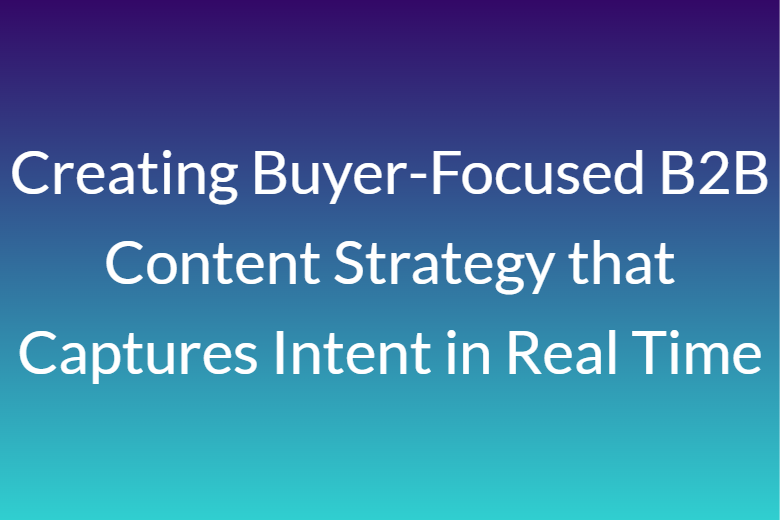Adapting to Real-Time Buyer Behavior in B2B
In 2025, B2B marketers must think beyond static campaigns and scheduled blog posts. Today’s buyers operate in real time—researching solutions across multiple touchpoints, platforms, and formats. A high-performing B2B Content Strategy anticipates and responds to this dynamic behavior using real-time intent data. When marketers can understand what content buyers are consuming now, what problems they’re solving, and where they are in the decision cycle, they can offer more relevant, timely content that increases engagement and conversion velocity.
Using Predictive Analytics to Anticipate Buyer Intent
Predictive analytics is playing a growing role in shaping B2B content. Through behavioral signals like site visits, time on page, content downloads, and email opens, marketers can predict future actions. A buyer who spends several minutes on your comparison guide may be considering switching vendors. A smart B2B Content Strategy uses this predictive data to trigger targeted actions: an automated email with a customer story, a chatbot prompt to schedule a call, or a follow-up from sales with more relevant resources. Predictive personalization strengthens your connection with buyers by staying a step ahead of their needs.
Structuring a Content Engine Around Buyer-Centric Themes
Buyer intent isn’t a moment—it’s a journey. Successful content strategies map entire ecosystems of content around core themes, all structured by what the buyer is actively searching for. A buyer researching “AI-driven lead generation” might first read a blog post, then explore an interactive infographic, then register for a webinar. Each asset deepens their knowledge and builds trust. A responsive B2B Content Strategy ensures that once intent is detected, content assets are sequenced in a way that supports logical and impactful discovery.
Nurturing High-Intent Leads With Multi-Format Content
Not every buyer consumes content the same way. Some prefer reading long-form reports, while others watch short videos or listen to podcasts. Your B2B Content Strategy must offer multi-format assets mapped to intent stage. Early intent may be best served with bite-sized blogs or educational explainer videos. Mid-stage intent aligns well with downloadable guides and webinars. Buyers nearing decisions are influenced most by testimonials, product walkthroughs, or pricing calculators. Offering various content types tailored to intent helps keep leads engaged and moving forward.
Leveraging Real-Time Data for Adaptive Campaigns
Adaptive campaigns are central to modern B2B content delivery. These are dynamic campaigns that change based on buyer interactions. A lead that clicks on an email offering a case study might be enrolled in a high-intent track that includes product comparisons and ROI resources. Another lead that bounces from a pricing page might be redirected toward softer, education-focused content. With a well-structured B2B Content Strategy, content delivery evolves with the buyer’s journey, reducing friction and improving pipeline performance.
Driving Buyer Engagement Through Contextual Personalization
Context is the currency of modern content strategy. Beyond using names and company fields, contextual personalization involves understanding a buyer’s pain points, challenges, and priorities—and adjusting the message accordingly. A B2B decision-maker from a startup needs different content than one from an enterprise. A context-aware B2B Content Strategy uses behavioral and firmographic data to personalize everything: email content, landing page copy, chatbot interactions, and even video intros. The result is a more intimate, high-value experience that feels like a one-on-one conversation rather than a mass broadcast.
Aligning Marketing and Sales Around Intent Signals
Buyer intent should serve as a bridge between marketing and sales. A siloed strategy causes lost opportunities, as marketers generate leads with strong intent but sales lacks context to close effectively. A connected B2B Content Strategy shares buyer data with sales in real time—highlighting what content was viewed, what topics were explored, and what emails were opened. Sales can then use this data to tailor their outreach with hyper-relevant messaging and content that continues the buyer journey instead of starting from scratch.
Using Heatmaps and Scroll Data to Refine Content Experience
One of the overlooked aspects of a successful B2B Content Strategy is UX optimization. Heatmaps, scroll depth data, and click tracking tools reveal how buyers interact with your content. Are they dropping off midway through your article? Are CTAs placed too low on the page? These micro-interactions signal intent—or the loss of it. By optimizing content layout based on actual user behavior, you improve readability, reduce bounce rates, and increase time on site—key metrics that reflect higher engagement and stronger buyer interest.
Triggering High-Performance Content Through Lifecycle Stages
Your content engine should be synchronized with the lead lifecycle—from visitor to MQL to SQL to customer and beyond. As leads progress, the intent behind their content consumption changes. A B2B Content Strategy must reflect this with evolving content experiences. For instance, new leads may need “why this solution” content, while sales-ready leads need “how it works” and “proof it works” content. Post-purchase, the focus shifts to adoption guides, training resources, and upsell content. Lifecycle-based content targeting ensures you stay relevant even after the sale.
Automating Content Distribution Without Losing Relevance
Marketing automation allows for scale, but scale means little without relevance. Email, chatbot, and ad workflows should all be governed by buyer intent—not a generic calendar. Your B2B Content Strategy should include intelligent triggers: a new blog read prompts a follow-up video email, an asset download leads to a nurture campaign, or repeated visits to your pricing page trigger a sales hand-off. Automation tied to intent behavior creates a content flow that feels personalized and timely, while freeing up marketing teams to focus on content quality and innovation.
Read the Full Blog Now @ https://acceligize.com/featured-blogs/smart-b2b-content-strategy-aligned-with-buyer-intent/
About Us
Acceligize is a global B2B lead generation and demand generation company, helping enterprises scale their revenue pipeline through intent-based marketing, content syndication, and integrated media solutions. Leveraging advanced targeting technologies and omnichannel strategies, Acceligize enables businesses to reach their ideal buyers with precision and at scale. Our mission is to deliver high-quality, marketing-qualified leads that drive measurable ROI. With our expertise in B2B webinar lead generation and beyond, we help companies connect with decision-makers and move prospects faster through the buyer journey.
